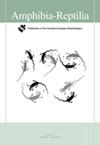An empty stomach is not a good adviser: avoiding toxic Cyanobacteria can compromise tadpole antipredator defenses
IF 1.3
4区 生物学
Q3 ZOOLOGY
引用次数: 0
Abstract
Abstract Eutrophication events resulting from increased primary production are becoming common under changing environmental conditions that include habitat degradation and disturbance of food webs. They cause several detrimental ecological consequences including the intoxication of animals that ingest toxic Cyanobacteria. We tested whether the tadpole of an anthropophilic frog ( Scinax longilineus ) would avoid feeding on a potentially toxic Cyanobacteria using Raphidiopsis raciborskii as a model. We maintained tadpoles in water collected from a natural monospecific growth of R. raciborskii at the original concentration (100%) and concentrations of 0, 25, 50 and 75% of the original sample diluted in rested tap water. We evaluated the amount of R. raciborskii ingested by the tadpoles and conducted behavioral tests by exposing tadpoles to an aversive stimulus and quantifying their escape response. Tadpoles ate the least R. raciborskii the highest the concentration of this Cyanobacteria was in the water. Tadpoles exposed to 50 and 75% of the original concentration of the R. raciborskii sample had a reduction of time spent escaping, what is likely to compromise their ability to escape a real predator attack. Tadpoles at the highest concentration (100%) did not show significant changes in their escape performance, however they practically stopped feeding, what would not be a solution in the long term (i.e., duration of a real bloom). We conclude that tadpoles of S. longilineus can recognize the presence of R. raciborskii and avoid its ingestion, with potential sub-lethal effects represented by a reduced ability to escape predators.空腹并不是一个好的建议:避免有毒的蓝藻会损害蝌蚪的反捕食者防御
在生境退化和食物网紊乱等环境条件变化的背景下,初级生产的增加导致的富营养化现象越来越普遍。它们会造成一些有害的生态后果,包括摄入有毒蓝藻的动物中毒。我们测试了亲人类青蛙(Scinax longilineus)的蝌蚪是否会避免以潜在有毒的蓝藻为食,使用Raphidiopsis raciborskii作为模型。我们将蝌蚪保持在原始浓度(100%)和原始样品的0%、25%、50%和75%稀释后的自来水中。我们评估了蝌蚪摄取量,并通过将蝌蚪暴露在厌恶刺激下并量化其逃避反应进行了行为测试。蝌蚪的食入量最少,水体中该蓝藻浓度最高。当蝌蚪暴露在原始浓度为50%和75%的raciborskii样本中时,它们逃跑的时间减少了,这可能会损害它们逃离真正捕食者攻击的能力。最高浓度(100%)的蝌蚪在逃跑表现上没有表现出明显的变化,但它们实际上停止了进食,这在长期(即真正的开花持续时间)内不会是一个解决方案。我们的结论是,长尾小蝌蚪可以识别raciborskii的存在并避免其摄入,潜在的亚致死效应表现为逃避捕食者的能力降低。
本文章由计算机程序翻译,如有差异,请以英文原文为准。
求助全文
约1分钟内获得全文
求助全文
来源期刊

Amphibia-Reptilia
生物-动物学
CiteScore
3.10
自引率
6.20%
发文量
39
审稿时长
6-12 weeks
期刊介绍:
Amphibia-Reptilia is a leading European multi-disciplinary journal devoted to most of the aspects of herpetology: ecology, behaviour, evolution, conservation, physiology, morphology, paleontology, genetics, and systematics.
Amphibia-Reptilia publishes high quality original papers, short-notes, reviews, book reviews and news of the Societas Europaea Herpetologica (SEH). The Societas Europaea Herpteologica (SEH) website is located at: www.seh-herpetology.org.
 求助内容:
求助内容: 应助结果提醒方式:
应助结果提醒方式:


